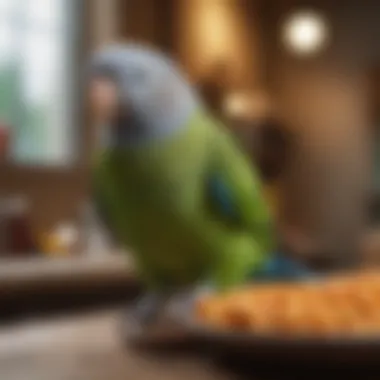Comprehensive Guide to Training Your Parakeet Effectively


Intro
Training a parakeet is an endeavor filled with joy and learning. Unlike a standard pet, parakeets are highly intelligent creatures with unique personalities. A well-informed approach to parakeet training can significantly improve not only their behaviors but also the bond between you and your feathered companion. Understanding their needs and motivations is crucial in creating an environment conducive to education and companionship.
In this guide, we will delve into various facets of parakeet training. Subjects will include care tips, understanding bird behavior, nutritional needs, health and wellness considerations, and activities that nurture and stimulate your parakeet's mind. Each section will aim to provide practical insights, making it easier for pet bird owners, aspiring bird parents, and bird breeders alike to cultivate a harmonious relationship with their parakeet.
Care Tips
Daily attention to a parakeet's needs can lay the groundwork for successful training. From providing proper hygiene to establishing a nurturing cage environment, these details have profound effects on behavior. Below are some important areas to focus on:
Daily Care Routines
Leaning into a structured daily routine can help contribute stability in a parakeet’s life. Fresh food and clean water should always be available. Once per day, check their energy levels and activity, as subtle changes may indicate something is not right. Regular social interaction each day is highly recommended.
Cage Setup and Maintenance
A suitable cage can serve as more than just a home. It's essential to choose a well-sized cage to allow enough space for them to stretch, fly short distances, and explore. Ensure the cage is free of hazards. Temperature, humidity, and even cage position can have an impact on well-being. Every few weeks, rearranging some toys provides novelty, keeping their environment engaging.
Hygiene and Cleaning Practices
Regular cleaning is vital in maintaining both health and hygiene. Every couple of days, remove any leftover food. The whole cage should undergo a satisfactory cleaning weekly, using bird-safe products. Doing this can limit potential infections or unwanted pests.
Seasonal Care Adjustments
Changes in seasons can impact native habits. In colder months, consider using a lamp for warmth; meanwhile, in warmer months, ensure there’s adequate ventilation. Being responsive to seasonal changes sets you up for responsible bird ownership, more conducive to effective training.
Behavioral Insights
Understanding parakeet behavior is not just useful but fundamental for effective training. Insight into their interpersonal communication methods presents clarity when assessing their needs or reactions.
Understanding Bird Body Language
Parakeets communicate through subtle body language. Observing subtle shifts in posture, feather positions and eye movements expands your ability to interact positively with your bird. A relaxed parakeet may exhibit slightly ruffled feathers, while folded wings can indicate that they feel threatened.
Common Behavioral Issues and Solutions
When a parakeet exhibits unwanted behaviors, it's crucial to lean into understanding. Common challenges include aggression, excessive screaming, and anxiety during handling. Each issue can frequently stem from changes in environment, lack of proper stimulation or insufficient training. Troubleshoot by evaluating their environment, ensuring plenty of engaging activities.
Positive Reinforcement Techniques
The effectiveness of positive reinforcement cannot be undervalued in bird training. A technique allowing birds to associate instructions with enjoyable stimuli can lead to a stronger rapport. For example, offering a favorite treat or praise when they execute a desired behavior can create an encouraging atmosphere conducive to learning.
Social Interaction Needs
Parakeets are inherently social creatures. It’s essential for them to interact not just with their environment but also with their owners. Daily inclusion in family routines can significantly enhance their psychological well-being.
A bird that feels connected to its owner is generally more willing to learn, interact, and engage.
In the next section, we will investigate the nutritional guidelines imperative for the health and development of parakeets.
Understanding Parakeet Behavior
Understanding the behavior of parakeets is fundamental to successful training. By comprehending their instincts and socialization processes, one can effectively foster a nurturing relationship that breeds trust and cooperation. Awareness of these facets not only enhances communication but allows owners to create a tailored environment conducive to growth. Positive interactions foster confidence, which plays a crucial role as birds master their training routines. Recognizing emotional cues and behavioral patterns leads to mindful adjustments of training techniques, responding to the bird's needs in real-time.
Natural Instincts and Socialization
Parakeets, being natural flock creatures, exhibit strong social instincts. In the wild, they thrive in large groups, forming close-knit communities which is evident in their affectionate demeanor. They communicate constantly using a variety of vocalizations, body language, and even physical touch. This socialization significantly impacts their learning processes. Owners must engage with their birds regularly to simulate this environment. By encouraging interactions, the owner helps develop a dynamic bond that eases training. Reinforcing this social connection with playtime and communication nurtures a trusting atmosphere, crucial for any training venture.
Recognizing natural instincts significantly enhances the training process. Birds are grounded in behaviors such as exploration and curiosity. Providing new experiences, toys, or challenges captures their attention and participation. Incorporate elements that mimic their natural habitat; for instance, climbing structures or foraging opportunities enable behavioral enrichment.
Communication Styles
Parakeets express themselves through a blend of vocalizations and body language. Understanding these communication styles enhances interactions, as it fosters a responsive and loving environment. Vocal communication comprises chirps, whistles, and chatter, each carrying specific meanings. Pay attention to the context in which these sounds occur to decipher their emotional states or needs.
Body language also plays a crucial role. From raised feathers to the tilt of their head, these signals provide insight into their feelings. A relaxed body posture and preening often indicate comfort, while sudden movements or fluffed feathers may point to unease.
Understanding this multifaceted communication deepens the bond between parakeet and owner, easing the learning experience.
Incorporating vocal and body language awareness into routine interactions not only aids in training but contributes positively to the bird's mental well-being. Achieving clarity in communication is key—adjust your training style based on how your bird responds. Meticulous attention to these details leads to an enriching training experience that recognizes and values the unique personality of each parakeet.
Preparing for Training
Preparing for the training of your parakeet is a critical step in ensuring its success. Training doesn't happen in a vacuum; various factors contribute to a productive learning experience. An informed approach here can lead to efficient sessions. By establishing appropriate environments and tools, you will maximize the potential benefits of training.
Creating a Safe Training Environment
Setting up a safe and comfortable environment for your parakeet is essential. Parakeets, like many birds, are naturally cautious creatures. If they feel threatened or unsure, learning will be hindered. Here are some key factors to consider:
- Quiet Space: Choose an area in your home that is quiet and free from distractions. Avoid areas with high foot traffic, noise, or other pets that might stress your bird.
- Familiarity: It is vital for your parakeet to feel comfortable in its surroundings. This requires creating a space that allows your bird to be itself. Keeping familiar items, such as perches and toys, can reduce anxiety.
- Safety: Ensure the environment is free from potential hazards. Remove sharp objects, toxic plants, and anything that your parakeet could ingest or get injured on. Parakeets often explore with their beaks, so safety should be prioritized.
Ensuring a peaceful environment enhances the parakeet’s willingness to engage in learning sessions. A feeling of security is fundamental here.
Essential Training Tools
The right tools can vastly improve your training process. Here’s a list of basic tools to consider for effective parakeet training:
- Treats: Use small, healthy treats as rewards. This is important for reinforcing positive behavior during training sessions. Fruit pieces, such as chopped apple or millet spray, can be good choices.
- Clicker: Consider using a clicker for precise behavioral marking. It helps clarify what behavior is being rewarded. The sound uniquely captures the moment
- Perches and Stands: Training is often more effective when the parakeet is perched comfortably. Having a designated training perch sets a clear boundary for catching their attention.
- Toys and Distractions: Having toys can keep your parakeet engaged and ready for training sessions. However, to minimize distractions when starting a lesson, keep exciting toys away from the training area.
Training tools serve as essential components to enhance the learning experience. Using effective materials tailored specifically for parakeets will streamline this process. As you prepare, these elements lay the groundwork for unraveling your bird's potential.
Basic Training Techniques
Basic training techniques serve as the foundation for effective parakeet training. These principles shape communication and help establish a strong bond between the bird and its owner. By focusing on these core elements, a parakeet can learn various behaviors that will enhance its wellbeing and make for a more natural relationship with its human companion.
Positive Reinforcement


Positive reinforcement involves rewarding your parakeet for desired behaviors. This form of training capitalizes on the bird's natural instincts to learn through rewards. Using treats like fresh fruits or seeds can motivate your pet to follow commands or actions you want to encourage.
The benefits of positive reinforcement are numerous:
- Enhanced Bonding: Creating positive associations leads to trust.
- Effective Learning: Birds respond better when they know they will be rewarded.
- Behavior Regulation: Reinforcing good behaviors can drastically reduce unwanted behaviors over time.
It is crucial to be consistent. When your parakeet performs a desired action, immediately follow it with a reward. Delaying the reward may confuse them as they could associate it with an unrelated behavior.
Target Training
Target training is a method where the trainer encourages the bird to touch a specific object, often referred to as a target. A common item is a small stick or a finger. This technique allows for effective communication and can be a precursor to more complex commands.
Steps to Implement Target Training:
- Introduce the target: Present the target close to your parakeet.
- Reward for touching: Convince your parakeet to touch the target using a treat.
- Gradually increase distance: Move the target gradually and reward them when they follow.
This technique helps in gaining control over training sessions and is especially helpful for socializing your bird by encouraging them to approach without fear. It has the additional benefit of enhancing their physical agility through movement.
Clicker Training
Clicker training uses a click sound to indicate that a parakeet has performed a correct action. Coupled with the subsequent reward, this technique trains birds to perform a myriad of behaviors. It efficiently bridges the communication gap between trainer and bird.
To start clicker training:
- Get a clicker: This can be a handheld clicker or just verbal clicking sounds.
- Pair the click with treats: Every time the bird performs the desired behavior, use the clicker followed immediately with a treat.
- Establish clear cues: Teach your parakeet what actions lead to the click and reward.
As training progresses, the clicker can be used in more personal context, allowing you and your parakeet to share a unique training language.
Effective training is not only about commands. It revolves around understanding and communication, promoting a mutually enjoyable experience.
Basic training techniques are the first steps toward developing a well-trained parakeet. By using positive reinforcement, target training, and clicker training, owners can nurture their bird's potential while strengthening their bond.
Advanced Training Techniques
Advanced training techniques are an essential part of the overall training process for parakeets. They go beyond the basic commands and work to deepen the bond between the owner and the bird, while also enriching the bird's experience. These techniques build upon the foundation laid in earlier training phases, enhancing not only learning capabilities but also encouraging proper mental and social development.
Trick Training
Trick training offers both entertainment and mental stimulation for your parakeet. It engages their mind and keeps them active. Through various tricks, one can focus on improving a parakeet’s dexterity, coordination, and learning capacity.
To get started with trick training, it's advisable to choose simple tricks that utilize the bird's natural behaviors. Things like:
- Wave hello: Teaching your parakeet to lift a foot to greet can be charming.
- Spin: Encouraging your bird to turn around allows for engagement and fun.
- Step-up: It reinforces trust as the bird learns to step onto your finger.
To ensure success, follow these steps:
- Use Positive Reinforcement: Always reward your parakeet with treats or affection when they successfully perform a trick. This reinforces the behavior and encourages repetition.
- Keep Sessions Short: Birds have short attention spans. Keep each training session brief, about 5 to 10 minutes.
- Use Clear Commands: Be consistent with your commands. Just like humans, birds respond better when there is structure.
Trick training not only serves as an enjoyable pastime but significantly contributes to cognitive development and physical well-being in parakeets.
Social Bonding Exercises
Social bonding exercises establish a significant relationship between the owner and the parakeet. Creating trust and reducing fear are foundational elements that make advanced training more effective. When birds feel secure, they are more likely to engage positively with their owners. This ultimately leads to stronger communication and fewer behavioral issues.
Effective social bonding exercises can include:
- Sharing Space: Spend time sitting near your bird’s cage. This helps them become accustomed to your presence without the pressure of direct interaction.
- Gentle Handling: Regular handling teaches your bird that interaction with humans is safe.
- Offering Treats: Letting the bird take treats from your hand helps them to associate you with positive experiences.
- Playdates: If possible, allow your parakeet to interact with other birds. This socialization teaches necessary behaviors and lowers stress.
Incorporating these exercises smoothly into day-to-day life creates familiar routines. Each interaction counts. Understanding that building trust takes time is essential. The results, however, are very rewarding. The more confident your parakeet feels, the more readily they will engage in the advanced training techniques you implement.
Addressing Behavioral Challenges
Addressing behavioral challenges is vital for successful parakeet training. Recognizing issues such as fear, anxiety, or aggression is the first step toward creating a harmonious relationship with your bird. Getting to the root of these behaviors influences not just training effectiveness but also the well-being of your pet.
Determining what triggers specific reactions in your parakeet is important. Common causes include changes in the environment, handling issues, or social stressors. By understanding these factors, owners can take steps to modify their approach and help their parakeets feel safe. When adapted correctly, you can often see remarkable improvements in associated behaviors. Consequently, a well-adjusted bird is easier to train and fosters a more rewarding companion experience.
Overcoming Fear and Anxiety
Fear and anxiety can severely hinder training success. Parakeets are naturally sensitive creatures. They may exhibit fear in response to loud sounds, sudden movements, or unfamiliar environments. The owner's patience and understanding are essential in helping a scared bird.
Establishing trust begins with creating a stable and positive environment. Gradually introducing your parakeet to new experiences can reduce anxiety levels. The following strategies may help:
- Take slow movements: Approach your bird calmly to avoid startling it.
- Use soothing tones: Gentle speaking can reassure your bird during training.
- Reward positive behavior: Offer treats when your parakeet displays calmness in challenging situations.
Providing a safe and predictable habitat will significantly reduce fear. Over time, you'll notice your parakeet becoming more comfortable with daily interactions and training sessions.
Dealing with Aggression
Aggression is another challenge that many parakeet owners face. Understanding the root causes is key. Aggression can stem from several factors, including territorial instincts, fear, and lack of socialization. Addressing aggressive behavior requires consistent and thoughtful tactics.
It’s important to handle aggression calmly. Reacting with anger or frustration can worsen the situation. Keep these guidelines in mind when dealing with an aggressive parakeet:
- Observe body language: Recognize warning signs that indicate stress or agitation.
- Avoid direct confrontations: If your parakeet is acting aggressively, give it space.
- Socialize slowly: Gradual introduction to new people or objects can help mitigiate defensive behavior.
Properly manage training sessions to focus on reinforcing non-aggressive behaviors. Whenever your parakeet responds positively or exhibits calmness, offer praise or treats as reinforcement. Over time, through repeated and positive interactions, many aggressive parakeets can learn to coexist peacefully and happily.
Understanding your parakeet's behavioral issues is essential for effective training. The commitment and consistency displayed by the owner greatly influence the transition to a positive relationship.
Establishing Routine and Consistency
Training a parakeet requires Routine and Consistency. These factors are pivotal for ensuring effective learning and bond building. A consistent approach reduces misunderstandings that may arise during training. Without these elements, the training experience can become erratic and confusing for the parakeet. This section will discuss the importance of maintaining a training schedule, the benefits it offers, and considerations for implementing routines.
The Importance of a Training Schedule
A training schedule guides both the bird and the owner. Consistent training sessions not only teach the parakeet specific behaviors but also Create a comfortable learning environment. By training at the same time each day, your parakeet learns to anticipate these moments, fostering a sense of security.


Here are some benefits of having a training schedule:
- Predictability: A set routine encourages your parakeet to learn commands. The bird begins to understand when it will learn, making it more focused.
- Engagement: Birds thrive on social interaction. Regular training keeps your parakeet engaged, stimulating its intellectual needs.
- Behavioral Reinforcement: Without routine, it may become difficult to reward desired behaviors promptly. A consistent schedule allows for immediate reinforcement, enhancing comprehension and retention.
Establishing a consistent schedule is more important than the duration of training sessions. Short, frequent sessions are likely more effective than long, infrequent ones.
When planning your training sessions, consider these aspects:
- Timing: Identify the periods your parakeet is most alert or active. Early mornings and late afternoons may work best.
- Duration: Keep sessions brief. Aim for 10-15 minutes. This duration allows focus without leading to fatigue.
- Flexibility: Life can be unpredictable. While consistent routines are valuable, allow adjustments when necessary. This will not harm your progress.
Evaluating Progress and Adjusting Techniques
Evaluating progress in parakeet training is a crucial phase that often leads to successful outcomes. Each parakeet is unique, and the training methods that work well for one bird might need adjustments for another. Regular assessment helps owners identify which techniques are effective and understand their bird's learning pace and preferences. It fosters patience and ensures consistency, both important traits in building a strong trainer-bird relationship.
Assessment of Training Outcomes
To genuinely appreciate the effectiveness of your training sessions, regular assessment is key. Consider keeping a training journal. In this journal, note down every session's specific objectives and outcomes. Did your parakeet successfully respond to a command, or was there resistance? Each observation contributes to understanding your parakeet's learning capabilities and behavioral nuances.
Follow these guidelines for assessment:
- Time Frame: Establish specific time frames for when you assess progress. Short intervals such as daily evaluations, or weekly summaries help you track fluctuations in behavior.
- Standardized Tasks: Implement similar tasks across different training sessions. Repeating certain commands, movements, or tricks allows you to measure improvements accurately.
- Behavioral Changes: Note any changes in behavior. Positive changes can show that your training method is working, whereas negative changes might prompt an assessment of your approach.
Reflect on the following indicators to better assess training outcomes:
- Increased responsiveness to cues or commands
- Show of eagerness to engage during training
- Improvement in social interaction and the bond you share
Ultimately, positive outcomes should lead to adjusting complexity in tasks as your parakeet learns.
Modifying Approaches Based on Behavior
Birds derive information from multiple sources, such as tone of voice, body language, and even the training environment. Modifying your approach based on observed behaviors is essential for positive reinforcement.
If you notice specific rental reluctance from your parakeet, here are some suggested steps for modification:
- Change the Setting: Sometimes a new environment can stimulate interest in training. A different room or location might eliminate any existing distractions.
- Alter Training Time: Timing can vary widely in effectiveness. Morning sessions might work better than evening ones or vice versa. Experiment with times to establish a routine that suits your parakeet.
- Experiment with Rewards: The reward type can significantly motivate a trainer's progress. If your bird does not respond positively to the current reward system, try different rewards such as varied treat options or engaging tasks. Often, a shift in Reinforcement—be it through treats or praise—can reinvigorate training motivation.
Consistency in actions enhances familiarity, thus minimizing anxiety in parakeets during practice.
Adapting methods continually based on consistent behavior observations is essential for ongoing learning and success in parakeet training. Being flexible and responsive maximizes engagement and enhances your bond with your avian companion.
For further reading on parakeet training evaluation, consider exploring resources such as Wikipedia or engaging in discussions on platforms like Reddit.
The Role of Nutrition in Training
Nutrition plays a critical role in the training of parakeets. Understanding how a proper diet can enhance learning and behavior is essential for any bird owner committed to effective training. Choosing the right foods not only supports physical health but also impacts cognitive function and social behavior. An optimized nutritional plan will enhance not only the general well-being of your pet but also create the optimal conditions for learning and interaction during training sessions.
Understanding Nutritional Needs
To train parakeets effectively, one must first grasp their specific nutritional needs. Parakeets require a balanced diet that typically includes seeds, pellets, fruits, and vegetables. Each component offers vital nutrients necessary for their overall health:
- Seeds: Though they are often favored, they should be given as part of a diverse diet. Seeds provide fats but may not contain all the necessary vitamins.
- Pellets: These offer a balanced nutrition source. They often have added vitamins and minerals.
- Fresh Fruits and Vegetables: Crucial for hydration and vitamins. Examples include carrots, broccoli, apples, and blueberries.
Monitoring the caloric intake is vital as you work through various training strategies. Obesity can lead to lethargy, impacting the ability and motivation of parakeets to participate in training sessions. Ensure that the proportion of each food type reflects both the age and activity level of the bird while taking care to avoid foods that are toxic, like avocado or chocolate.
Impact of Diet on Behavior
Diet significantly influences parakeet behavior. A well-nourished parakeet is typically more alert and willing to engage in training activities. Studies suggest that deficiencies in essential nutrients can result in behavioral issues like aggression or fearfulness. Other key points about diet’s role in behavior include:
- Mood Stability: Proper nutrition can help maintain an even temperament, reducing the chances of mood swings during training sessions.
- Cognitive Function: Omega-3 fatty acids and antioxidants, found in many vegetables and some seeds, support brain health, promoting better learning.
Regularly assess your parakeet’s dietary patterns to promote attentive behavior and facilitate positive training responses.
Creating an Enriching Environment
Creating an enriching environment is essential for the well-being and development of parakeets. A stimulating environment not only promotes mental activity but also helps prevent behavioral issues, as boredom can lead to negative behaviors in birds. A space designed with thoughtful consideration impacts their emotional health, enabling a fulfilling and harmonious life with their human companions.
Toys and Activities for Mental Stimulation
Providing toys and activities specifically designed for mental stimulation is a key aspect of enriching a parakeet's environment. Bird-appropriate toys should encourage the engagement of the mind. This keeps your parakeet active and encourages natural foraging behaviors.
Recommended Toys:
- Chew Toys: Encourage instinctual beaking and help with beak wear.
- Foraging Toys: Hide food within toys to stimulate searching behavior.
- Bells and Mirrors: Enable interactive play and curiosity while keeping birds stimulated visually and audibly.
- Puzzle Toys: Require effort to obtain treats and enhances problem-solving skills.
An array of toys can keep your parakeet entertained. Rotate these toys regularly. This way, the novelty will maintain their interest and mental stimulation. Remember that safety is crucial. Look for toys without toxic materials or small parts that could pose choking hazards.
Social Interaction and Play
Parakeets are inherently social creatures. Their need for interaction extends beyond sharing a space with human caregivers. Encouraging playtime will contribute significantly to their quality of life. Consider spending dedicated time every day to engage your parakeet in social play.
During these interactions, support behaviors like talking, climbing, or dancing on your finger. Creating permission for them to explore the environment enhances their sense of security. This contributes positively to their adaptability and behavior. Active engagement fosters trust between you and your parakeet, deepening your emotional bond.
Professional Training Resources
Professional training resources can significantly enhance the experience of training your parakeets. Beyond self-teaching, they offer insights rooted in extensive research and experience. Parakeets, like many companion animals, can present unique challenges that may not be easily overcome with trial and error. Thus, accessing professional resources can be beneficial for both the birds and their owners.
Finding Avian Behavior Experts
When searching for avian behavior experts, consider several approaches. Experienced avian trainers and bird behaviorists possess specialized knowledge and skills. They can provide tailored training strategies that meet the needs of your parakeet. Local avian veterinarians often know reputable instructors or can possibly provide services themselves. Look for professionals with credentials in animal behavior or psychology. Websites of recognized avian behavior associations can also list certified trainers.
Consider visiting online forums, community groups on Reddit, or even Facebook bird enthusiast pages. Asking for recommendations from fellow pet bird owners can lead to trustworthy professionals who have helped others achieve success in their training efforts.
Benefits of consulting an expert include:
- Personalized training strategies
- Advice tailored to specific behavior issues
- Support in nuanced situations involving temperamental birds


Engaging a professional is not indicative of failure. Instead, it reflects your commitment to understanding your pet better and fostering a meaningful bond.
Utilizing Online Courses and Workshops
The rise of digital learning has made online courses and workshops increasingly accessible. Many platforms offer parakeet training resources run by bird experts. These courses may vary from basic training techniques to advanced behavioral insights. Online videos and tutorials can effectively demonstrate concepts through visuals and expert narrations.
Additionally, workshops often provide a space for interaction, where participants can ask questions and engage with the instructor and peers. Check platforms like Coursera, Udemy, and specialized avian sites for relevant courses. Recommendations from community forums can guide you to high-quality resources.
Engaging with online courses offers the following advantages:
- Flexibility to learn at your own pace
- Access to a variety of instructional styles
- Opportunity to revisit complex subjects as necessary
Investing in professional training, whether through experts or digital resources, reflects dedication to your parakeet's well-being. You can nurture a positive environment conducive to learning, establishing long-term foundations for harmonious human-bird relationships.
Professional guidance not only enhances the training process, but it also promotes a deeper understanding of parakeet needs and behaviors. This ultimately results in a richer ownership experience.
Common Misconceptions About Parakeet Training
Parakeet training is a topic often clouded by myths and misunderstandings. Recognizing these misconceptions is critical for prospective bird owners. By debunking false information, owners can approach training effectively and cultivate a positive relationship with their parakeets. This section aims to illuminate those crucial aspects. With a clearer view on what to expect, enthusiasts can engage in experiências that promote harmony and skillful interaction with their feathered companions.
Debunking Training Myths
Many people believe that parakeets are untrainable or that training requires special skillsactics. This misinformation can dissuade committed owners from even attempting to work with their birds. In reality, while parakeets can possess stubbornness, they are highly intelligent creatures capable of learning various commands and tricks.
Some common myths include:
- Myth 1: Parakeets can learn anything quickly and easily.
In truth, parakeets may take time to understand commands. The learning process can vary significantly among individual birds. - Myth 2: Loud noise or yelling motivates training.
Harsh methods can stress parakeets or lead to fear, hindering training. Calm and gentle approaches are essential. - Myth 3: Older parakeets cannot learn new tricks.
While younger birds may adapt faster, older birds also have the potential to learn effectively.
This absence of understanding often leads many to abandon training altogether. With proper techniques and realistic expectations, successful training is plausible.
Understanding Parakeet Limits
During their training journeys, it's vital that owners acknowledge the natural limits of parakeets. Training should be guided by the bird’s physical and mental capabilities. Parakeets have varying attention spans, and an understanding of how much their feathery wards can absorb is crucial.
Consider key limits, such as:
- Attention Span: Parakeets can only focus for short periods. 5-10 minutes is often enough for a single training session.
- Stress Factors: Changes in environment or routine can induce stress. It is لاينبغي apply consistent training efforts within stable contexts.
- Social Needs: These birds are social creatures. Training should not substitute social interactions. Balance is essential among training, play, and time out of the cage.
Recognizing limits is important. Accept that achievements will vary among individuals. This perspective creates a more successful and enriching training and caring experience for pet owners.
Long-term Commitment to Training
Training your parakeet is not just an initial activity but requires a valuable long-term commitment. This process embarks on a journey of understanding, bonding, and continual adaptation to your bird's evolving personality and needs. Parakeets, like many pets, thrive on routine and familiarity. Consistency plays a crucial role in ensuring they respond positively to training efforts. When training is treated as merely a phase, the parakeets may not retain learned behaviors well.
Investing in the long-term commitment solidifies the relationship between you and your parakeet. Patience and time are necessary components. This commitment fosters an understanding of the individual personality of the bird. Knowledge of your parakeet's own unique nuances enables you to tailor training effectively.
Furthermore, maintaining a consistent approach invites the bird into a secure learning environment. Parakeets can show impressive capabilities. Some can learn words and tricks. What supports this success is not solely the initial training but continued engagement in numerous ways. The exhilaration that comes begins to fade, and skills can deteriorate without reinforcement. Regular practice, positive interactions, and experiences facilitate peak behavioral contributions.
"A consistent routine helps establish a bond and provides predictability, fostering trust and reducing stress."
In addition, long-term commitment compels owners to focus on ongoing enrichment. Parakeets require mental stimulation to thrive. This includes diverse activities— new tricks, toys, or even variations in your communication style. Dedicating time regularly enriches their lives and sharpens their skills further. Parakeets exhibiting anxiety or behavioral issues are less likely to improve unless there is consistent attention to both their training and emotional well-being.
Consistency Beyond the Initial Training
The immediate focus most parakeet owners have is the evident peaks of training. However, reinforcing learned skills takes precedence within a longer time frame. Establishing a recurring training schedule yields positive outcomes. This forces the owner to make sure of steady practices repeating them multiple times per week. Doing so solidifies learned behaviors.
Adopting small training sequnces allows combining reinforcement as you haw training sessions into your routine. Avoiding overwhelming sessions maintains the interest and focus of your parakeet. Consistency matters in potential school-like behaviors. Combine rewards, be it treats or praise. Social interaction forms the core of training successfully in a longer-term approach. Higher engagement will yield better evolvement in temperaments.
Your parakeet should see you not merely as a caretaker but as an integral partner in their developmental journey. Lastly, plan your milestones. Schedule periodic evaluations on learned behaviors and reflect on your training methods. Recognizing areas for growth beneficially authenticates your long-term investment.
Ethical Considerations in Training
Training a parakeet is more than merely teaching tricks or commands. It involves ethical responsibilities that impact the bird's welfare and overall well-being. Understanding ethical considerations ensures that the training process is conducive to both the bird and the owner, fostering a bond built on trust, respect, and empathy.
Promoting Animal Welfare
It is critical to promote animal welfare in every aspect of training. Here are several key points to consider:
- Respect for Autonomy: Birds have their own personality and preferences. Respecting their autonomy is important. Not every parakeet will respond well to advanced tricks. Owners must observe their birds closely and gauge their comfort levels.
- Avoiding Stress: Stress can have negative impacts on a parakeet. Owners should avoid training sessions that create anxiety. Gradual acclimatization to new environments and tools can help reduce fear. Leading by example encourages a more relaxed atmosphere.
- Rewards-Based Training: Offers a win-win for both parakeets and their owners. Using treats like seeds or favorite fruits as rewards helps birds associate training with positive experiences.
“Training is a journey towards mutual understanding rather than a test of dominance.”
- Socialization Needs: Parakeets are social creatures. Training sessions extended in time can serve not only as lessons but also as potential bonding times. Spending time around your parakeet daily contributes significantly to their happiness.
When discussing ethical considerations, it becomes apparent that success in parakeet training ultimately aligns with their nature and emotional needs. Owners who actively engage in fostering an ethical training atmosphere will not only see better results but also develop lifelong companionships with their birds. This continuous commitment is an integral part of responsible ownership and enriches the relationship between human and avian.
Finale
The conclusion of this article addresses critical aspects regarding the long-term commitment and understanding required in training parakeets. Training is not just a backyard pastime; it is an intricate process that fosters a deep bond between the owner and their feathered friend.
Key elements to consider in the conclusion include:
- Consistency: Ongoing engagement with your parakeet is imperative. Reinforcement of learned behaviors means that training must encompass daily interactions.
- Patience: Each bird has a unique temperament and skillset. The expectations placed upon them should mirror their inherent capabilities, ensuring training sessions can be steeped in positivity.
- Adaptable Methods: Training should evolve, matching the changing nuances of behavior and routine as time progresses. Owners must be flexible, ready to adapt techniques that best suit their parakeet's growing needs.
"% Everyday interactions build and reinforce knowledge in both bird and person. Choose patience each monteh, the longer commitment leader telling parakeets endless to learn."
Understanding these elements can significantly enhance how new and seasoned pet owners approach the journey of training. It highlights the balancing act required to sustain a balanced environment that contributes beneficially to and celebrates the learning journey of their cherished parakeet.
Recap of Key Points
In closing, here is a synthesis of the article's principal highlights in parakeet training:
- Understanding Behavior: Knowledge of parakeet instincts and communication patterns serves as the backbone for effective training.
- Creating the Right Environment: A secure and creativity-stimulating training area makes the training sessions successful.
- Techniques: The use of various training methods, such as positive reinforcement and clicker training, establish the foundation for effective teaching.
- Nutritional Insights: Proper nutrition vitally influences training outcomes, thus understanding nutritional needs is essential.
- Social Dynamic: Engaging with your parakeet through social interaction solidifies trust and aids in discipline during training.
Owners should frequently reference these points to empower their training experience.
Encouragement for Ongoing Learning
The quest for excellence in parakeet training does not conclude at a single milestone. Each aspect represents a chapter in a more extensive, intimate relationship between owner and pet. Learning is also an iterative process. Engaging with established resources can create avenues toward greater understanding of avianhabit.
- Participation in Workshops: Involvement in community events, whether local or online classes, promotes best practices in training techniques.
- Networking with Experts: Building relationships with experienced trainers will also offer valuable perspectives.
- Attendance at Forums: Platforms such as Reddit can provide insights and anecdotal learning from other parakeet aficionados.
Motivation continually underlines a superior bond; choose to embrace learning opportunities which the journey with your parakeet offers.















